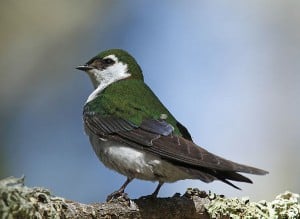This charming bird may be the most popular warbler in North America. It is certainly one of the most widespread and well known. Averaging about 5 inches in length, the common yellowthroat packs a lot of personality into a very small frame. Males are olive on top with a lemon-yellow throat and upper breast, white belly, yellow patch under the tail, and a bold black mask across the eyes, thinly bordered in white on top. The female is similar, but lacks the black mask.
These are very active little birds and seem to be less timid than most warblers, possibly because they are nearly always low to the ground and therefore relatively easy to view. Their distinctive song continues well into the heat of summer.
Listen for
Its repetitive song, written as witchety-witchety-witch actually does sound like that, and beginners trying to learn bird songs find that the yellowthroat’s is one of the easiest to master. Also utters several scold notes and rattles. Most common call note is buzzy and nasal: cherk!
Find it
Only in the dry southwestern states is the common yellowthroat hard to find during the breeding season. Everywhere else this little bird has no trouble locating the moist, shrubby, brushy conditions it needs for nesting.
Even a relatively small patch of suitable habitat will do for a single pair, while large areas may host many nests. In winter and on migration, yellowthroats extend their interests to include shrubby backyards, dry woodland edges, and similar sites.
Feed it
Yellowthroats are almost exclusively insect-eaters, though they will add a few small seeds to their diet from time to time. Some favored insects are moths, aphids, leafhoppers, small caterpillars, mayflies, grasshoppers, and grubs. Foraging is done low to the ground, in dense cover.
Nesting Behavior
Female yellowthroats build a bulky cup nest quite low to the ground in thick weeds, using grasses, sedges, and other materials taken from the surrounding area. After lining it with fine grasses and hair, she lays three to five eggs and incubates them for 12 days.
Her mate will bring her food during this time, and will then help her feed the nestlings for up to 10 days until fledging. The family stays together longer than most warblers, as the adults continue to feed the dependent young.
Common yellowthroats are frequent victims of cowbird nest parasitism and do not seem to have an adequate defense against it.
WOW!
One of the common yellowthroat’s folk names, Black-masked Ground Warbler, reflects the yellowthroat’s tendency to stay low to the ground nearly all the time.




